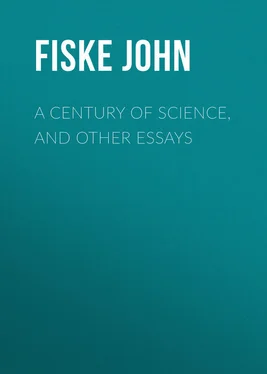John Fiske - A Century of Science, and Other Essays
Здесь есть возможность читать онлайн «John Fiske - A Century of Science, and Other Essays» — ознакомительный отрывок электронной книги совершенно бесплатно, а после прочтения отрывка купить полную версию. В некоторых случаях можно слушать аудио, скачать через торрент в формате fb2 и присутствует краткое содержание. Жанр: foreign_antique, foreign_prose, на английском языке. Описание произведения, (предисловие) а так же отзывы посетителей доступны на портале библиотеки ЛибКат.
- Название:A Century of Science, and Other Essays
- Автор:
- Жанр:
- Год:неизвестен
- ISBN:нет данных
- Рейтинг книги:3 / 5. Голосов: 1
-
Избранное:Добавить в избранное
- Отзывы:
-
Ваша оценка:
- 60
- 1
- 2
- 3
- 4
- 5
A Century of Science, and Other Essays: краткое содержание, описание и аннотация
Предлагаем к чтению аннотацию, описание, краткое содержание или предисловие (зависит от того, что написал сам автор книги «A Century of Science, and Other Essays»). Если вы не нашли необходимую информацию о книге — напишите в комментариях, мы постараемся отыскать её.
A Century of Science, and Other Essays — читать онлайн ознакомительный отрывок
Ниже представлен текст книги, разбитый по страницам. Система сохранения места последней прочитанной страницы, позволяет с удобством читать онлайн бесплатно книгу «A Century of Science, and Other Essays», без необходимости каждый раз заново искать на чём Вы остановились. Поставьте закладку, и сможете в любой момент перейти на страницу, на которой закончили чтение.
Интервал:
Закладка:
When once the truth of Lyell's conclusions began to be distinctly realized, their influence upon men's habits of thought and upon the drift of philosophic speculation was profound. The conception of Evolution was irresistibly forced upon men's attention. It was proved beyond question that the world was not created in the form in which we find it to-day, but has gone through many phases, of which the later are very different from the earlier; and it was shown that, so far as the inorganic world is concerned, the changes can be much more satisfactorily explained by a reference to the ceaseless, all-pervading activity of gentle, unobtrusive causes such as we know than by an appeal to imaginary catastrophes such as we have no means of verifying. It began to appear, also, that the facts which form the subject-matter of different departments of science are not detached and independent groups of facts, but that all are intimately related one with another, and that all may be brought under contribution in illustrating the history of cosmic events. It was a sense of this interdependence of different departments that led Auguste Comte to write his "Philosophie Positive," the first volume of which appeared in 1830, in which he sought to point out the methods which each science has at command for discovering truth, and the manner in which each might be made to contribute toward a sound body of philosophic doctrine. The attempt had a charm and a stimulus for many minds, but failed by being enlisted in the service of sundry sociological vagaries upon which the author's mind was completely wrecked. "Positivism," from being the name of a potent scientific method, became the name of one more among the myriad ways of having a church and regulating the details of life.
While the ponderous mechanical intellect of Comte was striving to elicit the truth from themes beyond its grasp, one of the world's supreme poets had already discerned some of the deeper aspects of science presently to be set forth. By temperament and by training, Goethe was one of the first among evolutionists. The belief in an evolution of higher from lower organisms could not fail to be strongly suggested to a mind like his as soon as the classification of plants and animals had begun to be conducted upon scientific principles. It is not for nothing that a table of classes, orders, families, genera, and species, when graphically laid out, resembles a family tree. It was not long after Linnæus that believers in some sort of a development theory, often fantastic enough, began to be met with. The facts of morphology gave further suggestions in the same direction. Such facts were first generalized on a grand scale by Goethe in his beautiful little essay on "The Metamorphoses of Plants," written in 1790, and his "Introduction to Morphology," written in 1795, but not published until 1807. In these profound treatises, which were too far in advance of their age to exert much influence at first, Goethe laid the philosophic foundations of comparative anatomy in both vegetal and animal worlds. The conceptions of metamorphosis and of homology, which were thus brought forward, tended powerfully toward a recognition of the process of evolution. It was shown that what under some circumstances grows into a stem with a whorl of leaves, under other circumstances grows into a flower; it was shown that in the general scheme of the vertebrate skeleton a pectoral fin, a fore leg, and a wing occupy the same positions: thus was strongly suggested the idea that what under some circumstances developed into a fin might under other circumstances develop into a leg or a wing. The revelations of palæontology, showing various extinct adult forms, with corresponding organs in various degrees of development, went far to strengthen this suggestion, until an unanswerable argument was reached with the study of rudimentary organs, which have no meaning except as remnants of a vanished past during which the organism has been changing. The study of comparative embryology pointed in the same direction; for it was soon observed that the embryos and larvæ of the higher forms of each group of animals pass, "in the course of their development, through a series of stages in which they more or less completely resemble the lower forms of the group." 4 4 Balfour, Comparative Embryology , i. 2.
Before the full significance of such facts of embryology and morphology could be felt, it was necessary that the work of classification should be carried far beyond the point at which it had been left by Linnæus. In mapping out the relationships in the animal kingdom, the great Swedish naturalist had relied less than his predecessors upon external or superficial characteristics; the time was arriving when classification should be based upon a thorough study of internal structure, and this was done by a noble company of French anatomists, among whom Cuvier was chief. It was about 1817 that Cuvier's gigantic work reached its climax in bringing palæontology into alliance with systematic zoölogy, and effecting that grand classification of animals in space and time which at once cast into the shade all that had gone before it. During the past fifty years there have been great changes made in Cuvier's classification, especially in the case of the lower forms of animal life. His class of Radiata has been broken up, other divisions in his invertebrate world have been modified beyond recognition, his vertebrate scheme has been overhauled in many quarters, his attempt to erect a distinct order for Man has been overthrown. Among the great anatomists concerned in this work the greatest name is that of Huxley. The classification most generally adopted to-day is Huxley's, but it is rather a modification of Cuvier's than a new development. So enduring has been the work of the great Frenchman.
With Cuvier the analysis of the animal organism made some progress in such wise that anatomists began to concentrate their attention upon the study of the development and characteristic functions of organs. Philosophically, this was a long step in advance, but a still longer one was taken at about the same time by that astonishing youth whose career has no parallel in the history of science. When Xavier Bichat died in 1802, in his thirty-first year, he left behind him a treatise on comparative anatomy in which the subject was worked up from the study of the tissues and their properties. The path thus broken by Bichat led to the cell doctrine of Schleiden and Schwann, matured about 1840, which remains, with some modifications, the basis of modern biology. The advance along these lines contributed signally to the advancement of embryology, which reached a startling height in 1829 with the publication of Baer's memorable treatise, in which the development of an ovum is shown to consist in a change from homogeneity to heterogeneity through successive differentiations. But while Baer thus arrived at the very threshold of the law of evolution, he was not in the true sense an evolutionist; he had nothing to say to phylogenetic evolution, or the derivation of the higher forms of life from lower forms through physical descent with modifications. Just so with Cuvier. When he effected his grand classification, he prepared the way most thoroughly for a general theory of evolution, but he always resisted any such inference from his work. He was building better than he knew.
The hesitancy of such men as Cuvier and Baer was no doubt due partly to the apparent absence of any true cause for physical modifications in species, partly to the completeness with which their own great work absorbed their minds. Often in the history of science we witness the spectacle of a brilliant discoverer travelling in triumph along some new path, but stopping just short of the goal which subsequent exploration has revealed. There it stands looming up before his face, but he is blind to its presence through the excess of light which he has already taken in. The intellectual effort already put forth has left no surplus for any further sweep of comprehension, so that further advance requires a fresher mind and a new start with faculties unjaded and unwarped. To discover a great truth usually requires a succession of thinkers. Among the eminent anatomists who in the earlier part of our century were occupied with the classification of animals, there were some who found themselves compelled to believe in phylogenetic evolution, although they could frame no satisfactory theory to account for it. The weight of evidence was already in favour of such evolution, and these men could not fail to see it. Foremost among them was Jean Baptiste Lamarck, whose work was of supreme importance. His views were stated in 1809 in his "Philosophic Zoölogique," and further illustrated in 1815, in his voluminous treatise on invertebrate animals. Lamarck entirely rejected the notion of special creations, and he pointed out some of the important factors in evolution, especially the law that organs and faculties tend to increase with exercise, and to diminish with disuse. His weakest point was the disposition to imagine some inherent and ubiquitous tendency toward evolution, whereas a closer study of nature has taught us that evolution occurs only where there is a concurrence of favourable conditions. Among others who maintained some theory of evolution were the two Geoffroy Saint-Hilaires, father and son, and the two great botanists, Naudin in France and Hooker in England. In 1852 the case of evolution as against special creations was argued by Herbert Spencer with convincing force, and in 1855 appeared "The Principles of Psychology," by the same author, a book which is from beginning to end an elaborate illustration of the process of evolution, and is divided from everything that came before it by a gulf as wide as that which divides the Copernican astronomy from the Ptolemaic.
Читать дальшеИнтервал:
Закладка:
Похожие книги на «A Century of Science, and Other Essays»
Представляем Вашему вниманию похожие книги на «A Century of Science, and Other Essays» списком для выбора. Мы отобрали схожую по названию и смыслу литературу в надежде предоставить читателям больше вариантов отыскать новые, интересные, ещё непрочитанные произведения.
Обсуждение, отзывы о книге «A Century of Science, and Other Essays» и просто собственные мнения читателей. Оставьте ваши комментарии, напишите, что Вы думаете о произведении, его смысле или главных героях. Укажите что конкретно понравилось, а что нет, и почему Вы так считаете.












